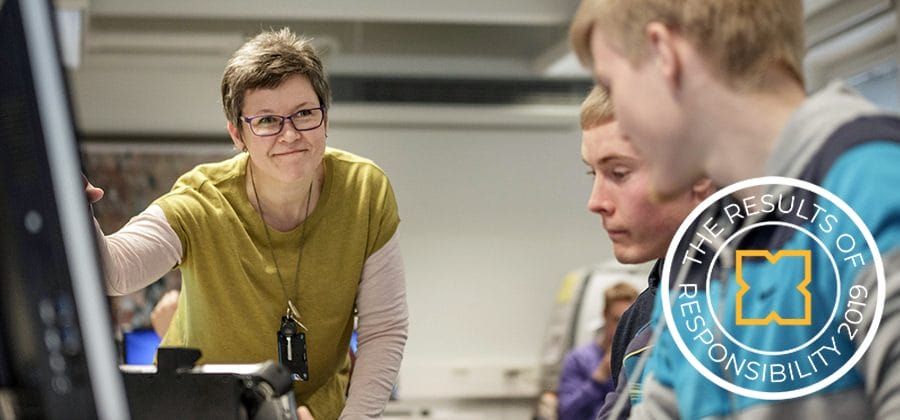Xamk’s finances in 2019
 The year 2019 was the third year of South-Eastern Finland University of Applied Sciences Ltd as a higher education institution as defined in the Finnish Universities of Applied Sciences Act. The company’s main operations remained the same throughout the financial year. There were no material changes in the company structure, locations or organisation.
The year 2019 was the third year of South-Eastern Finland University of Applied Sciences Ltd as a higher education institution as defined in the Finnish Universities of Applied Sciences Act. The company’s main operations remained the same throughout the financial year. There were no material changes in the company structure, locations or organisation.
Investment in strategic goals
The operational result for 2019 was negative by EUR 1.5 million as planned. The core funding from the government decreased by approximately EUR 1.4 million from the previous year, amounting to approximately EUR 54 million in 2019.
The company decided to invest heavily in the support and development of the functions that promote the achievement of Xamk’s strategic goals. Therefore, costs were not cut in proportion to the decrease in funding. The upcoming increase in core funding in 2020 was predicted to restore a balance between income and expenditure. By using retained earnings from previous years to cover the loss for the financial year, the continuity of operations was secured and the effects on society and stakeholders’ finances were minimised.
Xamk is a major economic and RDI player in its region
Xamk has a significant economic impact on its region. In 2019, the company made EUR 16 million worth of purchases from its region, supporting the business community in South-East Finland.
During the financial year, the company paid out EUR 41 million in salaries and fees. Most of this amount has a direct effect on the purchasing power of the region.
The company’s annual turnover was EUR 74.2 million, a decrease of EUR 1.8 million compared with 2018. The most important reason for the decrease was the lower core funding from the government. In addition, sales of services decreased.
External funding of research, development and innovation (RDI) activities continued to increase, as expected. The amount of financial support and subsidies increased by EUR 1.5 million from the previous year. In 2019, the amount of external research funding exceeded EUR 15 million for the first time. Measured with this indicator, Xamk’s research and development activities were, once again, in a class of their own.
Controlled costs and increasing personnel
Personnel costs in 2019 amounted to approximately EUR 50 million, representing 65.8 per cent of Xamk’s total costs. Xamk had 815 employees on average, an increase of 5.7 per cent from the previous year.
The total occupancy costs were the second largest cost category, representing 13 per cent of the total costs. The percentages in different cost categories have remained relatively unchanged over the past three years.
Excellent solvency and liquidity
 Xamk’s financial position is good. The company’s solvency and liquidity are excellent. The quick ratio calculated from current assets and current liabilities on the balance sheet was 2.7, while the target ratio for good liquidity is 1. The key figures indicating solvency – equity ratio 73.4 per cent and net gearing -58.7 per cent – are excellent.
Xamk’s financial position is good. The company’s solvency and liquidity are excellent. The quick ratio calculated from current assets and current liabilities on the balance sheet was 2.7, while the target ratio for good liquidity is 1. The key figures indicating solvency – equity ratio 73.4 per cent and net gearing -58.7 per cent – are excellent.
Xamk’s economy provides security for the future
The result for 2020 is predicted to be close to zero. Compared with 2019, core funding from the government will increase significantly. The growth of funding is based on good operational performance as well as a general increase and index-based increase of government funding to universities of applied sciences.
The performance-based funding model will be reformed as of January 2021. On 17 January 2019, the Government approved the funding models of universities of applied sciences for the agreement period 2021–2024.
In the new funding model, the importance of the number of graduates is increased. Cost differences in different fields of study will be taken into account in funding paid on the basis of the number of graduates, and faster graduation is emphasised.
The position of RDI activities, master’s programmes and continuous learning is also enhanced in the new funding model. The changes to the funding model are favourable for Xamk. The increase in funding expected in 2021 may be quite significant compared with 2020.




